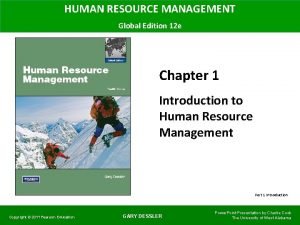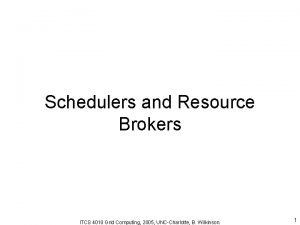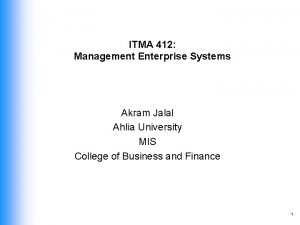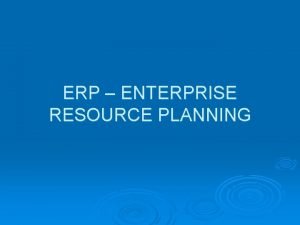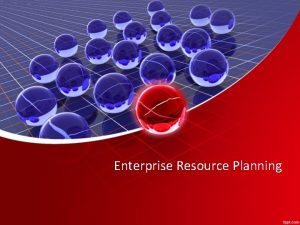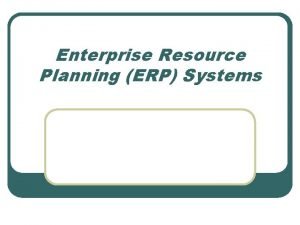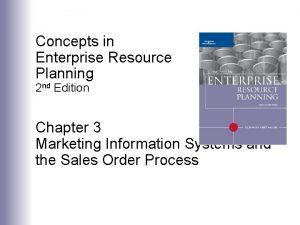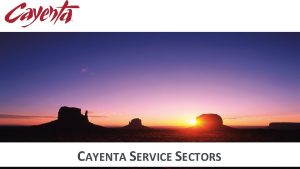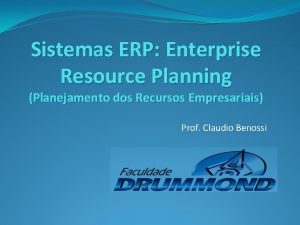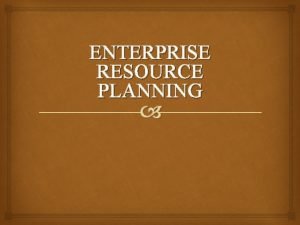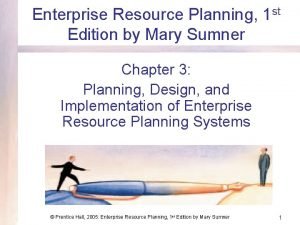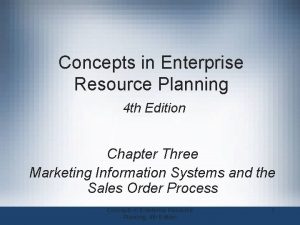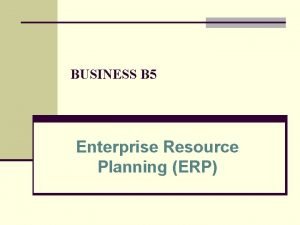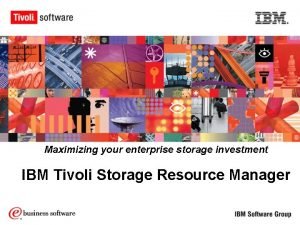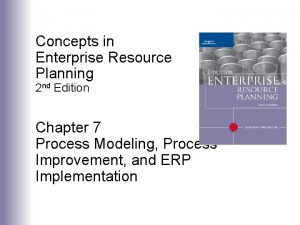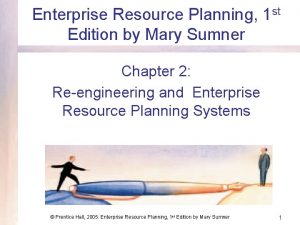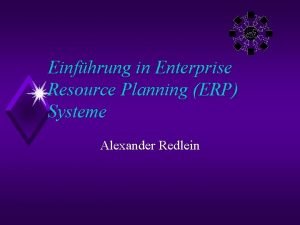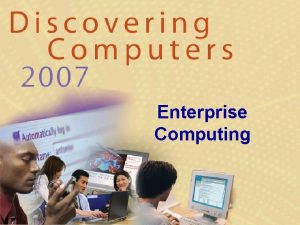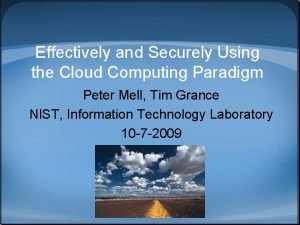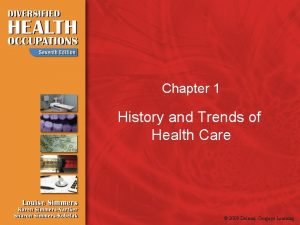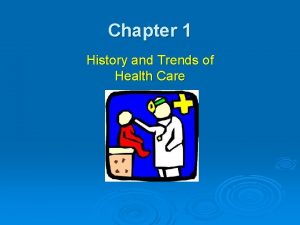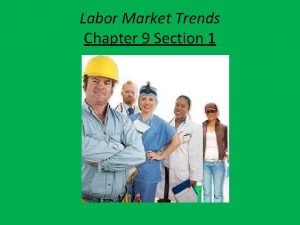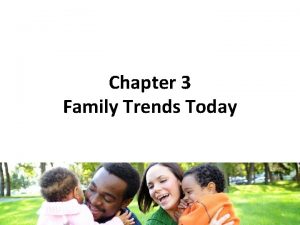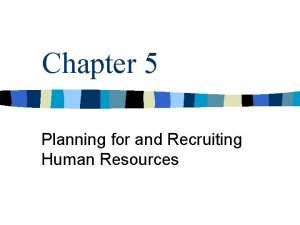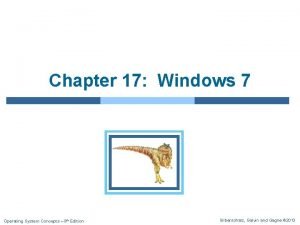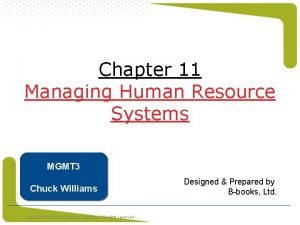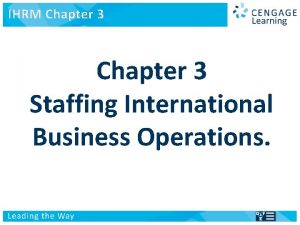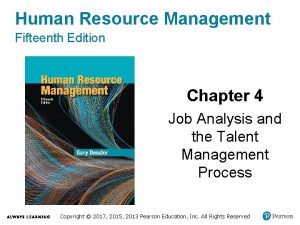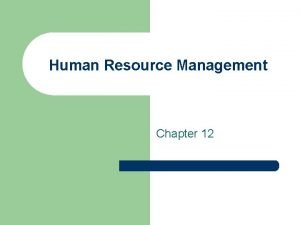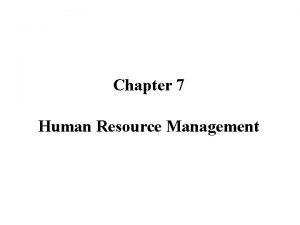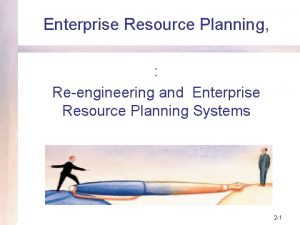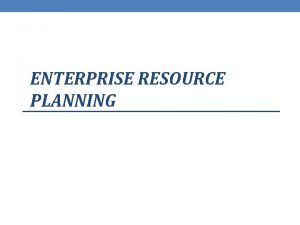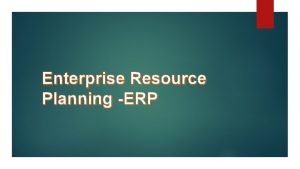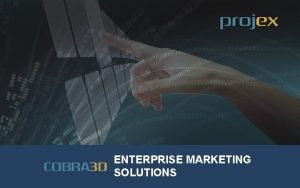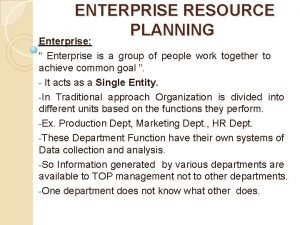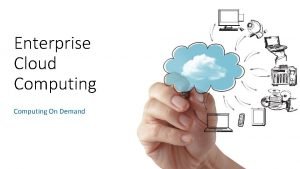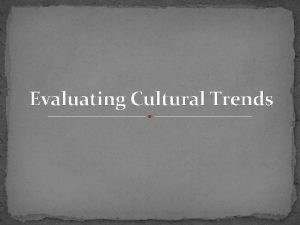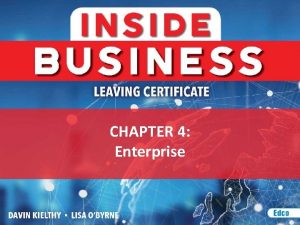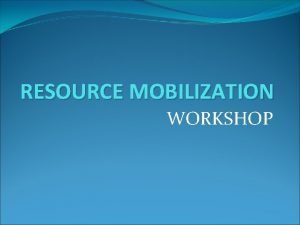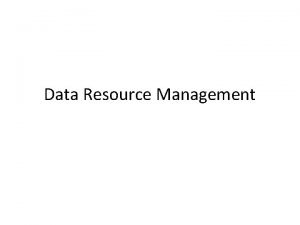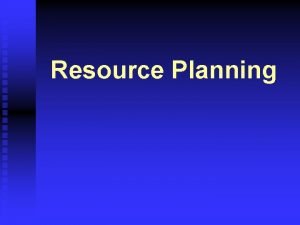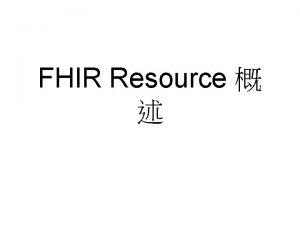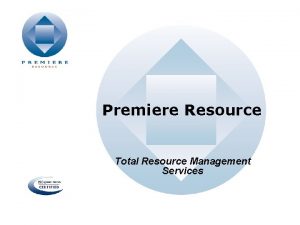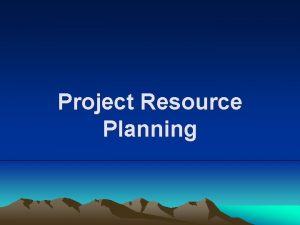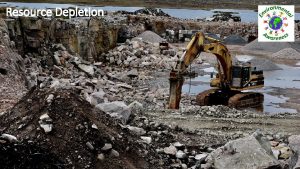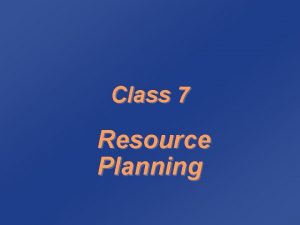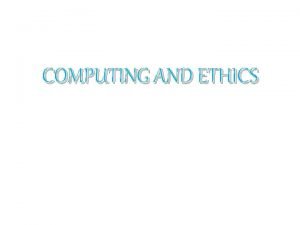CHAPTER 4 Enterprise Computing Trends and Enterprise Resource














































- Slides: 46

CHAPTER 4 Enterprise Computing Trends and Enterprise Resource Planning Opening Case: Shell Canada Fuels Productivity with ERP Mc. Graw-Hill-Ryerson © 2011 The Mc. Graw-Hill Companies, All Rights Reserved

4 -2 Chapter Four Overview • SECTION 4. 1 - ENTERPRISE COMPUTING TRENDS – – Innovation: Finding New Social Entrepreneurship: Going Green Social Networks: Who’s Who Virtual Worlds: It’s a Whole New World • SECTION 4. 2 – ENTERPRISE RESOURCE PLANNING – – – – Enterprise Resource Planning Core ERP Components Extended ERP Components Integrating SCM, CRM, and ERP Measuring ERP Success Choosing ERP Software ERP and SME Markets Copyright © 2011 Mc. Graw-Hill Ryerson Limited

4 -3 LEARNING OUTCOMES 1. Explain what enterprise computing trends are happening in organizations today (e. g. innovation, going green, social networks, and virtual worlds). 2. Understand enterprise resource planning as a management approach and how information systems can help promote ERP. 3. Describe the components of ERP systems and the differences between them. Copyright © 2011 Mc. Graw-Hill Ryerson Limited

4 -4 LEARNING OUTCOMES 4. Explain the business value of integrating supply chain management, customer relationship management, and enterprise resource planning systems together. 5. Explain how an organization can measure ERP success, choose ERP software, and use ERP in SME markets. Copyright © 2011 Mc. Graw-Hill Ryerson Limited

SECTION 4. 1 ENTERPRISE COMPUTING TRENDS Mc. Graw-Hill-Ryerson © 2011 The Mc. Graw-Hill Companies, All Rights Reserved

4 -6 INNOVATION: FINDING NEW Six Best Practices of Innovation Copyright © 2011 Mc. Graw-Hill Ryerson Limited

4 -7 Energy Consumption Breakdown of Power Usage in The Typical Data Centre Copyright © 2011 Mc. Graw-Hill Ryerson Limited

4 -8 Recycle IT Equipment Some Provincial E-Waste Recycling Programs Copyright © 2011 Mc. Graw-Hill Ryerson Limited

4 -9 Greener IT Ways To Go Green Copyright © 2011 Mc. Graw-Hill Ryerson Limited

4 -10 SOCIAL NETWORKS: WHO’S WHO Organizational Social Networking Copyright © 2011 Mc. Graw-Hill Ryerson Limited

4 -11 VIRTUAL WORLDS: IT’S A WHOLE NEW WORLD Copyright © 2011 Mc. Graw-Hill Ryerson Limited

4 -12 OPENING CASE QUESTIONS Shell Canada 1. How can large organizations like Shell Canada use innovation to fuel productivity? 2. What advantages are there for Shell Canada to recycle its IT equipment? How could recycling IT equipment be potentially threatening to Shell Canada? Copyright © 2011 Mc. Graw-Hill Ryerson Limited

4 -13 OPENING CASE QUESTIONS Shell Canada 3. How could Shell Canada use social networking to boost productivity and increase profits? 4. How could Shell Canada use virtual worlds such as Second Life to make the company more successful? Give specific examples. Copyright © 2011 Mc. Graw-Hill Ryerson Limited

SECTION 4. 2 ENTERPRISE RESOURCE PLANNING Mc. Graw-Hill-Ryerson © 2011 The Mc. Graw-Hill Companies, All Rights Reserved

4 -15 ENTERPRISE RESOURCE PLANNING • Enterprise resource planning – integrates all departments and functions throughout an organization into a single IT system (or integrated set of IT systems) so that employees can make enterprisewide decisions by viewing enterprise-wide information on all business operations Copyright © 2011 Mc. Graw-Hill Ryerson Limited

4 -16 ENTERPRISE RESOURCE PLANNING Copyright © 2011 Mc. Graw-Hill Ryerson Limited

4 -17 ENTERPRISE RESOURCE PLANNING Enterprise Resource Planning System Copyright © 2011 Mc. Graw-Hill Ryerson Limited

4 -18 ENTERPRISE RESOURCE PLANNING ERP Integration Data Flow • At the heart of all ERP systems is a database; when a user enters or updates information in one module, it is immediately and automatically updated throughout the entire system Copyright © 2011 Mc. Graw-Hill Ryerson Limited

4 -19 ENTERPRISE RESOURCE PLANNING ERP Process Flow Copyright © 2011 Mc. Graw-Hill Ryerson Limited

4 -20 ENTERPRISE RESOURCE PLANNING The organization before ERP Copyright © 2011 Mc. Graw-Hill Ryerson Limited

4 -21 ENTERPRISE RESOURCE PLANNING The organization after ERP Copyright © 2011 Mc. Graw-Hill Ryerson Limited

4 -22 CORE AND EXTENDED ERP COMPONENTS The Evolution of ERP Copyright © 2011 Mc. Graw-Hill Ryerson Limited

4 -23 CORE AND EXTENDED ERP COMPONENTS Copyright © 2011 Mc. Graw-Hill Ryerson Limited

4 -24 CORE AND EXTENDED ERP COMPONENTS Core ERP component – traditional components included in most ERP systems and they primarily focus on internal operations (karena pada mulanya ERP dikembangkan untuk proses MRP) Extended ERP component – extra components that meet the organizational needs not covered by the core components and primarily focus on external operations Copyright © 2011 Mc. Graw-Hill Ryerson Limited

4 -25 CORE ERP COMPONENTS • Three most common core ERP components 1. Accounting and finance 2. Production and materials management 3. Human resource Copyright © 2011 Mc. Graw-Hill Ryerson Limited

4 -26 Accounting and Finance ERP Components • Accounting and finance ERP component – manages accounting data and financial processes within the enterprise with functions such as general ledger, accounts payable, accounts receivable, budgeting, and asset management Copyright © 2011 Mc. Graw-Hill Ryerson Limited

4 -27 Production and Materials Management ERP Components • Production and materials management ERP component – handles the various aspects of production planning and execution such as demand forecasting, production scheduling, job cost accounting, and quality control Copyright © 2011 Mc. Graw-Hill Ryerson Limited

4 -28 Production and Materials Management ERP Components Copyright © 2011 Mc. Graw-Hill Ryerson Limited

4 -29 Human Resource ERP Component • Human resource ERP component – tracks employee information including payroll, benefits, compensation, performance assessment, and assumes compliance with the legal requirements of multiple jurisdictions and tax authorities Copyright © 2011 Mc. Graw-Hill Ryerson Limited

4 -30 EXTENDED ERP COMPONENTS • Extended ERP components include: – Business intelligence – Customer relationship management – Supply chain management – E-business Copyright © 2011 Mc. Graw-Hill Ryerson Limited

4 -31 E-Business Components • E-business components include e-logistics and e-procurement – E-logistics – manages the transportation and storage of goods – E-procurement – the business-to-business (B 2 B) purchase and sale of supplies and services over the Internet Copyright © 2011 Mc. Graw-Hill Ryerson Limited

4 -32 INTEGRATING SCM, CRM, AND ERP SCM Market Overview Copyright © 2011 Mc. Graw-Hill Ryerson Limited

4 -33 INTEGRATING SCM, CRM, AND ERP CRM Market Overview Copyright © 2011 Mc. Graw-Hill Ryerson Limited

4 -34 INTEGRATING SCM, CRM, AND ERP Primary Users and Business Benefits of Strategic Initiatives Copyright © 2011 Mc. Graw-Hill Ryerson Limited

4 -35 Integration Tools • Many companies purchase modules from an ERP vendor, an SCM vendor, and a CRM vendor and must integrate the different modules together – Middleware – several different types of software which sit in the middle of and provide connectivity between two or more software applications – Enterprise application integration (EAI) middleware – packages together commonly used functionality which reduced the time necessary to develop solutions that integrate applications from multiple vendors Copyright © 2011 Mc. Graw-Hill Ryerson Limited

4 -36 INTEGRATING SCM, CRM, AND ERP Integrations Between SCM, CRM, and ERP Applications Copyright © 2011 Mc. Graw-Hill Ryerson Limited

4 -37 THE CONNECTED CORPORATION • SCM, CRM, and ERP are the backbone of e-business • Integration of these applications is the key to success for many companies • Integration allows the unlocking of information to make it available to any user, anywhere, anytime Copyright © 2011 Mc. Graw-Hill Ryerson Limited

4 -38 MEASURING ERP SUCCESS Balanced scorecard is a management system, in addition to a measurement system, that enables organizations to clarify their vision and strategy and translate them into action. Copyright © 2011 Mc. Graw-Hill Ryerson Limited

4 -39 MEASURING ERP SUCCESS The Four Primary Perspectives of the Balanced Scorecard Copyright © 2011 Mc. Graw-Hill Ryerson Limited

4 -40 CHOOSING ERP SOFTWARE Successful ERP projects share 3 attributes 1. Overall fit • • • Off the rack and tailored to fit Custom made 2. Proper business analysis • Successful companies spend up to 10 percent of the project budget on a business analysis 3. Solid implementation plans • A plan is needed to monitor the quality, objectives, and timelines Copyright © 2011 Mc. Graw-Hill Ryerson Limited

4 -41 ERP AND SME MARKETS • ERP is no longer the purview of large organizations. • In the hopes of expanding their client base, many large-scale ERP vendors, such as SAP and Oracle, are attempting to enter the small to medium enterprise (SME) market Copyright © 2011 Mc. Graw-Hill Ryerson Limited

4 -42 OPENING CASE QUESTIONS Shell Canada 5. How did ERP help improve business operations at Shell Canada? 6. How important was training in helping roll out the system to Shell Canada personnel? 7. How could extended ERP components help improve business operations at Shell Canada? 8. What advice would you give Shell Canada? Copyright © 2011 Mc. Graw-Hill Ryerson Limited

4 -43 CLOSING CASE ONE Confusing Carbon 1. How can companies help reduce carbon emissions? 2. How can finding alternative energy sources help reduce IT energy consumption? 3. How can labelling IT equipment green help promote green initiatives? 4. Why do global organizations need to be concerned with green or social entrepreneurship initiatives? 5. What ethical issues are associated with green technology? Copyright © 2011 Mc. Graw-Hill Ryerson Limited

4 -44 CLOSING CASE TWO Campus ERP 1. How could core ERP components help improve business operations at your school? 2. How could extended ERP components help improve business operations at your school? 3. How can integrating SCM, CRM, and ERP help improve business operations at your school? 4. What lessons can be learned from this case in terms of dealing with the challenges of implementing an ERP information system at your school? Copyright © 2011 Mc. Graw-Hill Ryerson Limited

4 -45 CLOSING CASE THREE Intuitive ERP 1. How well do the components of the Intuitive ERP software product align with the ERP components described in this chapter? 2. What advantages did Fibre Connections and Westwinn Group Corp. realize with the introduction of Intuitive ERP? How well do these advantages resonate with the benefits of ERP described in this chapter? Copyright © 2011 Mc. Graw-Hill Ryerson Limited

4 -46 CLOSING CASE THREE Intuitive ERP 3. The successful implementation of Intuitive ERP described above does not speak of any negative outcomes or drawbacks of introducing a new enterprise-wide information system in an organization. • What challenges do you envision would occur in a company that decides to introduce such large-scale change? What drawbacks, if any, are there in adopting a software solution from a single vendor that serves such a critical and important role in an organization? How could one mitigate or lessen these drawbacks? Copyright © 2011 Mc. Graw-Hill Ryerson Limited
 Globalization and competition trends in hrm
Globalization and competition trends in hrm Conventional computing and intelligent computing
Conventional computing and intelligent computing Resource allocation vs resource leveling
Resource allocation vs resource leveling Perbedaan resource loading dan resource leveling
Perbedaan resource loading dan resource leveling Resource broker in grid computing
Resource broker in grid computing Search image
Search image Enterprise collaboration market trends
Enterprise collaboration market trends Enterprise resource planning example
Enterprise resource planning example Enterprise resource definition
Enterprise resource definition Enterprise resource planning overview
Enterprise resource planning overview Application of enterprise resource planning
Application of enterprise resource planning Enterprise resource planning concepts
Enterprise resource planning concepts Cayenta payroll management
Cayenta payroll management Enterprise resource planning tradução
Enterprise resource planning tradução Pengertian erp system
Pengertian erp system Enterprise resource planning mary sumner
Enterprise resource planning mary sumner Concepts in enterprise resource planning
Concepts in enterprise resource planning Core and extended erp components
Core and extended erp components Contemporary management practices
Contemporary management practices Enterprise storage resource management
Enterprise storage resource management Fitter snacker
Fitter snacker Enterprise resource planning mary sumner
Enterprise resource planning mary sumner Sap lieferplan kopierer sd
Sap lieferplan kopierer sd What is enterprise computing
What is enterprise computing Cloud computing paradigm
Cloud computing paradigm Chapter 1 history and trends of health care
Chapter 1 history and trends of health care History and trends of health care
History and trends of health care Chapter 9, section 1: labor and wages worksheet answers
Chapter 9, section 1: labor and wages worksheet answers Family trends meaning
Family trends meaning Putting the enterprise into the enterprise system
Putting the enterprise into the enterprise system Putting the enterprise into the enterprise system
Putting the enterprise into the enterprise system Forestry and resource management chapter 11 answers
Forestry and resource management chapter 11 answers Battling over clayoquot big trees
Battling over clayoquot big trees Chapter 5 human resource planning and recruitment
Chapter 5 human resource planning and recruitment Current and future trends of media and information quiz
Current and future trends of media and information quiz Hrm chapter 2
Hrm chapter 2 Chapter 9 human resource management
Chapter 9 human resource management Windows 7 resource kit (chapter 17)
Windows 7 resource kit (chapter 17) Chapter 11 human resource management
Chapter 11 human resource management Human resource management chapter 1
Human resource management chapter 1 Chapter 1 introduction to human resource management
Chapter 1 introduction to human resource management Human resource management 15th edition
Human resource management 15th edition Human resource management lecture chapter 1
Human resource management lecture chapter 1 Chapter 3 human resource management
Chapter 3 human resource management Human resource management chapter 4
Human resource management chapter 4 Functions of hrm
Functions of hrm Chapter 7 human resource management
Chapter 7 human resource management
